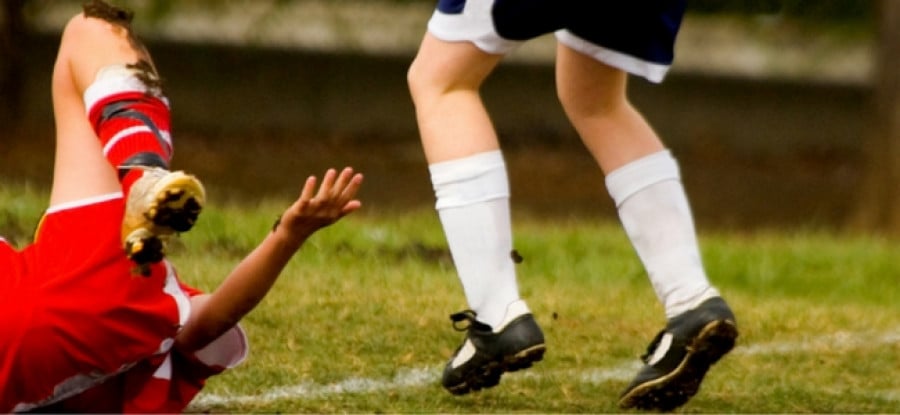An overview of key case law relating to negligent liability for sports injuries (Part 2)

To succeed in an action of negligence, the victim must be able to prove three things:
- That he was owed a duty of care
- That that duty of care was breached
- The damage suffered was caused by that breach
In contact sports, such as football or rugby, all participants owe a duty of care to one another. In order to show a breach of that duty, conduct must be reckless and fall below the standard required of a reasonably skilful and competent professional player. It must be an act that is more serious than an error of judgement. Thereafter, the injury suffered must be foreseeable. For example, it must be the type of injury that one would expect from a foul or tackle. Given that, the test for negligence in the sporting world is a high threshold to meet.
In sport, it is not always the assailant who is open to be sued – players, clubs, governing bodies and referees can also find themselves subject to legal action, which will be explored in the case law discussed. This two-part article examines the extent of liability in negligence for sporting injuries arising in eight different sports. Part 1 (available here) looked specifically at the issue in football. Part 2 (below) moves on to consider the following sports:
- Rugby
- Jarrod Mccracken v Melbourne Storm Rugby League Club and Ramsay Elshafey v Javed Clay
- Extending liability to referees
- Vowles v Evans
- Concussion
- American Football
- Mike Webster
- Motor racing
- Wattleworth V Goodwood Racing Co Ltd
- Swimming
- Tomlinson v Congleton Borough Council
- Simulated Rock Climbing
- Poppleton v Trustees of Portsmouth Youth Activities Committee
- Skiing
- Anderson v Lyotier t/a “Showbizz"
- Kearne v Ultima Tours
- Boxing
- Watson v British Boxing Board of Control
- The Importance of Evidence in Proving a Breach of Duty
Rugby
Rugby is a dangerous sport with heavy body collisions between players and regularly, multiple players at any given time. Therefore, it is likely that injuries arising from such play occur frequently but when do they occur as an act of negligence?
Again, the focus will always be on what is expected of the reasonably competent rugby player, what care has been shown in the tackles, what is regarded as an error of judgement compared to complete recklessness and of course, the Court will consider the rules of the game.
As discussed above, there are a number of possibilities when considering who an action can be brought against following a sporting injury claimed to have arisen as a result of negligence.
There are two cases whereby rugby players have recovered from their fellow players following injuries caused by “spear” tackles.
Jarrod Mccracken v Melbourne Storm Rugby League Club1 (2005) and Ramsay Elshafey v Javed Clay2 (2001)
Both players alleged that they were injured as a result of a “spear” tackle whereby both players were lifted off the ground and allowed to fall headfirst. The Courts, in both cases, commented that rugby is a fast moving, intense physical contest involving heavy body collisions. However, the assailants were aware of what they were doing when they lifted and upended their opponents. They had intended them to fall heavily to the ground below. Given that, the Court held that the defendants had breached their duty of care.
Extending liability to referees
Vowles v Evans3(2003).
In some instances, players may also seek compensation from a referee. This was the focus in the case of Vowles v Evans. The pursuer, Vowles, was seriously injured during a rugby match when the scrum collapsed. A prop forward had previously left the field with an injury and the referee had permitted a flanker to take his place in the front row without enquiring as to his previous experience of playing prop. This was a breach of the rules. It was argued, by the claimant, that it was that negligence that caused the scrum to collapse.
The referee argued that he did not owe a duty of care to the players. That argument was rejected by the Court of Appeal stating that Rugby is an inherently dangerous sport and some of the rules are designed to minimise the risks associated with it. Players depend on the rules to ensure their safety and it is for the referee to enforce those rules. In performing his role, a referee is expected to exercise reasonable care.
The standard of care expected of the referee is determined on all the circumstances and nature of the game. A referee of a fast moving game cannot reasonably be expected to avoid errors of judgement, oversights or lapses. Given that, the threshold of liability must be high. However, given the facts of this particular case, the Court held that the threshold had been met and crossed and the referee was found to be liable which meant that the Welsh Rugby Union was vicariously liable for his actions, given he was their employee.
Concussion in Rugby
The recent headlines of Wales international, Jonathan Thomas, having to retire due to epilepsy is a stark reminder of the inherent head injury risks associated with rugby.
It is alleged that the number of concussions in the game has doubled in the last five years and that on average, one player at every Six Nations match suffered a brain injury.
In England, the number of reported concussions rose by 59% in 2013/14 and in Scotland the number of cases has nearly doubled in the last two years. It is claimed that this is as a result of the rugby unions calling for head related injuries to be flagged up.
Given the recent studies and media focus on the topic, the rugby governing bodies have introduced guidelines and protocols in relation to the risks associated with head injuries. Both English and Scottish Rugby Unions are trying to make the game safer and increase awareness of concussion.
The International Rugby Board has introduced the Head Injury Assessment protocol that includes a ten minute assessment procedure. There is also a compulsory online module for players, coaches and officials and mandatory concussion management training for medical staff. The management of confirmed and suspected concussion is also subject to an independent review by no less than two experienced independent medical practitioners.
For more on the legal implications of concussion in contact sports, please see here.4
For an overview of concussion protocols across professional sports leagues, please see here.5
American Football
To continue reading or watching login or register here
Already a member? Sign in
Get access to all of the expert analysis and commentary at LawInSport including articles, webinars, conference videos and podcast transcripts. Find out more here.
- Tags: American Football | Boxing | Concussion | Football | Governance | Insurance | International Rugby Board (IRB) | Liability | Motor racing | National Football League (NFL) | Negligence | Premier League | Premier League Concussion Protocol | Regulation | Rock Climbing | Rugby | Skiing | Swimming | UEFA | United Kingdom (UK) | Wales
Related Articles
- An overview of concussion protocols across professional sports leagues
- The legal implications of concussion in contact sports
- Who shoulders the blame? An analysis of vicarious liability in the sports industry
- An overview of key case law relating to negligent liability for sports injuries (Part 1)
Written by
Laura McCallum
Solicitor, Lombardi Associates
Laura is a Scottish solicitor, having qualified in 2013. She obtained her LLB degree at the University of Strathclyde. Prior to joining Lombardi Associates, Laura was a solicitor at two major city law firms in Glasgow. Her legal experience to date spans a variety of practice areas including general dispute resolution, housing law, medical law, personal injury, professional negligence and sports law.

 Global Summit 2024
Global Summit 2024